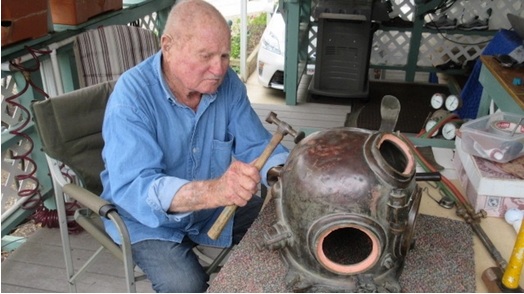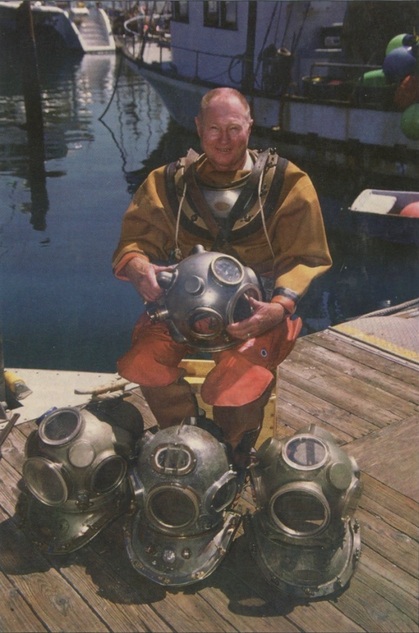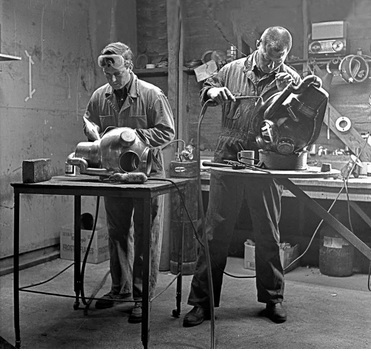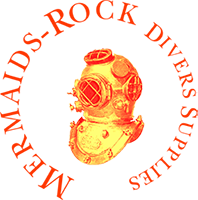In Memoriam | Bob Kirby: 1933-2022
In Memoriam | Bob Kirby: 1933-2022
In Memoriam By Leslie Leaney and Chris Swann
Credit: Leslie Leaney Archives

Bob Kirby, a true diving pioneer whose achievements in both diving and aviation over seven decades earned him lasting international recognition, passed away on June 2, 2022, at his home in Carpinteria.
Bob’s diving career started in the early 1950s as a Second-Class Diver on a U.S. Navy vessel based in San Diego. Thanks to his mechanical ability, inventiveness, and ability to read blueprints, he soon made himself indispensable. When badly damaged submarines were brought in for repairs, he was given the job of carrying out the underwater work with his own crew — and with First-Class Divers tending him, rather than the other way round. Bob Kirby | Credit: Steve Barsky
The Jack Browne surface-supplied mask the Navy was using was totally inadequate for diving in the heavily polluted water of San Diego Bay, so Bob started building his own masks on the ship, which he subsequently sold to the abalone divers he dived with on weekends.
On leaving the Navy, Bob went into abalone diving in Santa Barbara, then into oilfield and construction diving. In 1963 he used his skills as a remarkable metalsmith to design a mixed-gas recirculating diving helmet with a small team of colleagues at Associated Divers. Bob’s helmet design was a major factor in the successful expansion of deep water mixed-gas diving that flourished in Santa Barbara in the early 1960s, and gradually spread around the globe.

In 1965 Bob joined forces with Bev Morgan and created the Kirby Morgan company that was to revolutionize the equipment of military and commercial diving.
No two people were more suited to the task.
As Bob commented: “Although it might seem obvious, a designer and builder of professional diving equipment must himself be, or have been, a commercial diver. Numerous people, many of them brilliant, have over the years inflicted all manner of discomfort on divers simply because they were not aware of the inherent difficulties. What is it like, for example, to experience hypothermia or carbon dioxide build-up in deep water? It helps to know such things. Second, the designer needs to have an intuition about what will and will not work, combined with a certain artistic sense; and third, he must have the intelligence to merge everything into a whole.”
Bob and Bev designed and created modern lightweight fiberglass helmets that replaced the traditional copper and brass helmets that had been the diving industry standard for over a century. Their work revolutionized the industry. It is estimated that their company Kirby Morgan Diving Systems International now has more than 80 percent of the global surface-supplied diving equipment market. Some estimates put that percentage even higher.
Bob also donated his time and considerable expertise in educating the younger divers who he taught at the Marine Diving Technology Program at SBCC and also at specialist traditional diving equipment courses for the Historical Diving Society USA. As a director of the Diving Society,
Bob was also instrumental in developing the inaugural diving exhibits at the S.B. Maritime Museum, of which he and his wife, Claudia, were valued members. His friend, film director James Cameron, hired Bob and his son Troy, to develop and build the unique helmets for his blockbuster film The Abyss.
Bob later committed his life story into print with his 2002 self-published book Hard Hat Divers Wear Dresses, recording his early abalone diving years followed by his historic contributions to equipment design as the deep-water Santa Barbara Helium Rush took off in the 1960s.
Bob also had a lengthy career connection to aviation, and he could often be found in someone’s hangar where his metalwork and engineering skills were appreciated. In 2008 his second book, Aviation Visionary, Smilin’ Jack Conroy, was published. Co-written with George M. Warner, it detailed the career of Conroy, who created the distinctive Pregnant Guppy aircraft and later founded the Conroy Aircraft Corporation. Bob Kirby (right) and Bev Morgan construct two commercial helium re-circulator helmets in 1966, which Kirby had designed. One of the helmets is on display at the Santa Barbara Maritime Museum. | Credit: Courtesy
Bob’s skills as a master metalsmith were shared in a 16-chapter video series on tools and techniques used in building a Kirby helmet. The sophistication of the diving equipment Bob and Bev designed may one day surface in their entirety, but for now, they occasionally can be found in U.S. Navy, CIA, and NSA publicly available information associated with Operation Ivy Bells in the Sea of Okhotsk. Bob’s career achievements were recognized with the Historical Diving Society’s Diving Pioneer Award, the Academy of Underwater Arts & Sciences NOGI Award, and with induction into the Association of Diving Contractors International Commercial Diving Hall of Fame. Those fortunate enough to have been befriended or mentored by Bob were blessed with the good fortune of time spent with an honorable, ethical, and immensely talented diver and educator, whose name will live on as long as there are professional divers working in the world’s oceans and waterways.

President Kennedy once said, “One person can make a difference, and everyone should try.” Bob was one of those Americans who did both, and every member of the international diving industry owes him sincere thanks for that. He was truly unique and will be missed by many.
Bob is survived by Claudia, his wife of 66 and a half years, their two sons, Troy and Jeff, and their two grandchildren, Garett and Alina. In lieu of flowers, the family suggests a donation to the Santa Barbara based nonprofits, the Historical Diving Society USA at hds.org or the Santa Barbara Maritime Museum at sbmm.org.
LATEST ARTICLES
- “El Buzo,” or “The Diver,”... Statue... Mexico.
- Dive Into History
- Depth Of The Deepest Dive With Breathing Apparatus
- A BRIEF HISTORY OF DIVING: FREE DIVERS, BELLS AND HELMETS
- Saturation Diving Technique
- 20,000 lies under the sea ... The fishy world of Jacques Cousteau
- Royal de Luxe ... The Giant Diver Mechanical Marionette
- Europe's first underwater museum opens off Lanzarote
- Cousteau legacy still making a splash
- In Memoriam | Bob Kirby: 1933-2022
- The COMEX Story
- 10 Things No One Tells You Before You Become A Deep Sea Diver
- Diving Suits through History
- Training And Qualifications in Commercial Diving
- Australia’s deepest ever commercial dive leads to brain injuries, mental scarring


